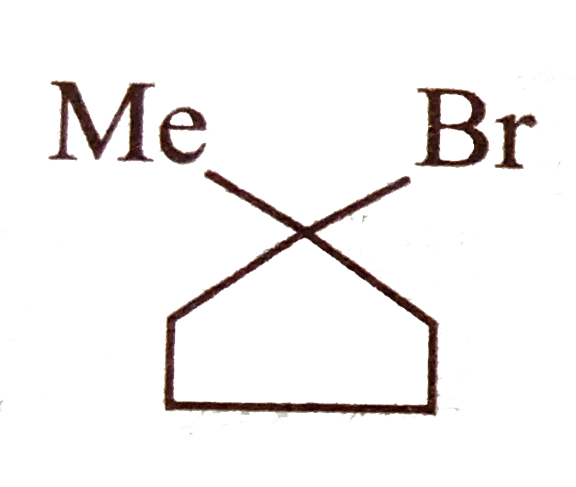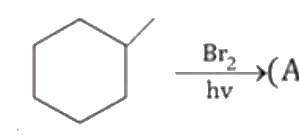C6H12 (A)Br2/hv−−−−−−−−−−→Monobromination One isomer (B)
C6H12 (C) Br2/hv−−−−−−−−−−→Monobromination Number of isomers including geometrical isomers
Both (A) and (C) do not decolourise Baeyer's reagent or Br2 solution.
Which of the statements is/are correct ?
(a) Compound (A) and (B) are, respectively,

(b) Compound (C) is 
(c) The total number of isomers obtained by monobro-mination of (C) is six including geometrical isomer.
(d) The major product of monobromination of (C) is

The correct Answer is:A, B, C, D
To solve the problem, we need to analyze the monobromination of two different compounds, both with the molecular formula C6H12. Let's denote the first compound as (A) and the second as (C).
1. Identify Compound (A):
- Compound (A) is cyclohexane, which has the formula C6H12.
- When cyclohexane undergoes monobromination with Br2 in the presence of light (hv), it can form one isomer (B) because all carbon atoms in cyclohexane are equivalent. Thus, bromine can attach at any carbon, but the product will be the same regardless of where the bromine is attached.
2. Identify Compound (C):
- Compound (C) is likely to be a branched alkane, such as 2-methylpentane or 3-methylpentane, which also has the formula C6H12.
- When this compound undergoes monobromination, we need to consider the different positions where bromine can attach and the possibility of forming geometric isomers (cis/trans).
3. Count Isomers for Compound (C):
- For a branched alkane like 2-methylpentane, bromine can attach to different carbon atoms, leading to different structural isomers.
- The possible positions for bromination can yield several unique structures, including cis and trans isomers if there are double bonds or rings present.
4. Determine the Number of Isomers:
- After analyzing the potential structures formed from the monobromination of compound (C), we find that there are 6 distinct isomers, including geometric isomers.
5. Reactions with Baeyer's Reagent and Bromine:
- Both compounds (A) and (C) do not decolorize Baeyer's reagent or bromine solution, indicating that they do not contain double bonds or other unsaturated functionalities.
6. Conclusion:
- The statements regarding the formation of one isomer from (A) and six isomers from (C) including geometric isomers are correct. Therefore, all statements provided in the question are true.
Summary of Statements:
- Statement about (A) forming one isomer is correct.
- Statement about (C) forming six isomers including geometric isomers is correct.
- Both compounds do not decolorize Baeyer's reagent or bromine solution, confirming they are saturated.
Final Answer:
All statements regarding compounds (A) and (C) are correct.
---
- Compound (A) is cyclohexane, which has the formula C6H12.
- When cyclohexane undergoes monobromination with Br2 in the presence of light (hv), it can form one isomer (B) because all carbon atoms in cyclohexane are equivalent. Thus, bromine can attach at any carbon, but the product will be the same regardless of where the bromine is attached.
- Compound (C) is likely to be a branched alkane, such as 2-methylpentane or 3-methylpentane, which also has the formula C6H12.
- When this compound undergoes monobromination, we need to consider the different positions where bromine can attach and the possibility of forming geometric isomers (cis/trans).
- For a branched alkane like 2-methylpentane, bromine can attach to different carbon atoms, leading to different structural isomers.
- The possible positions for bromination can yield several unique structures, including cis and trans isomers if there are double bonds or rings present.
- After analyzing the potential structures formed from the monobromination of compound (C), we find that there are 6 distinct isomers, including geometric isomers.
- Both compounds (A) and (C) do not decolorize Baeyer's reagent or bromine solution, indicating that they do not contain double bonds or other unsaturated functionalities.
- The statements regarding the formation of one isomer from (A) and six isomers from (C) including geometric isomers are correct. Therefore, all statements provided in the question are true.
- Statement about (A) forming one isomer is correct.
- Statement about (C) forming six isomers including geometric isomers is correct.
- Both compounds do not decolorize Baeyer's reagent or bromine solution, confirming they are saturated.
All statements regarding compounds (A) and (C) are correct.
Topper's Solved these Questions
- ALKANES AND CYCLOALKANESBOOK - CENGAGE CHEMISTRY ENGLISHCHAPTER - ALKANES AND CYCLOALKANESEXERCISE - Single Correct
45 Videos
- ALKANES AND CYCLOALKANESBOOK - CENGAGE CHEMISTRY ENGLISHCHAPTER - ALKANES AND CYCLOALKANESEXERCISE - Archives
13 Videos
- ALKANES AND CYCLOALKANESBOOK - CENGAGE CHEMISTRY ENGLISHCHAPTER - ALKANES AND CYCLOALKANESEXERCISE - Reasoning and Assertion
2 Videos
- ALKENES AND ALKADIENESBOOK - CENGAGE CHEMISTRY ENGLISHCHAPTER - ALKENES AND ALKADIENESEXERCISE - Single correct Answer
14 Videos
Similar Questions
The number of unbranched isomers (including stereoisomers) of C6H12 are
View SolutionC6H5CH3Br2/FeBr3−−−−−−→ the reaction is called
View SolutionC2H4Br2−−→XKCN−−→Y,Y is
View SolutionTotal number of possible structural isomers of C5H11Br.
View SolutionCyclobutylethe≠(A) Dil.H2SO4−−−−−−→ (B) (Number of isomeric products including stero-isomers)
View SolutionThe number of constitutional isomers of the formula C5H11 Br is
View Solution Br2−−→hv(A)alc. KOH−−−−→(B)OsO4−−→(C)HlO4−−→(D), Identify 'D'
Br2−−→hv(A)alc. KOH−−−−→(B)OsO4−−→(C)HlO4−−→(D), Identify 'D'
View SolutionCH3−CH2−O∣∣C−OAgBr2−−→CCl4X(1) Li−−−→(2) CuIYCH3−CH2−Br−−−−−−−−−→dry etherZ
View SolutionThe number of optically active compounds in the isomers of C4H9Br is
View SolutionC5H10H2/Ni−−−→(X)Cl2/hv−−−→3 monochloro structural isomers for compound C5H10 how many pairs of geometrical isomers are possible
View Solution
